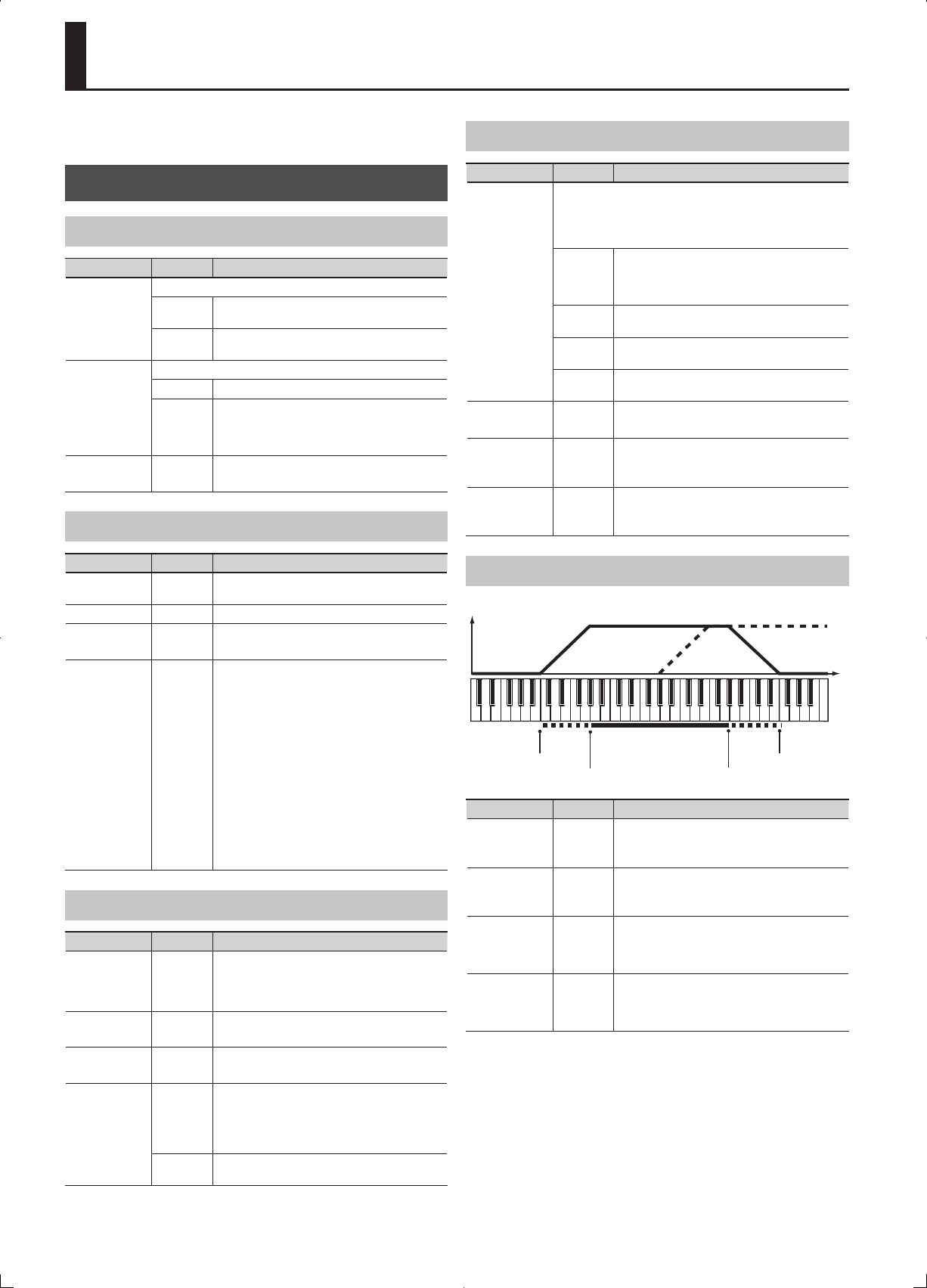
36
For details on how to edit in each screen, refer to “Basic Operations in
the LIVE SET EDIT Screen” (p. 34).
LIVE SET EDIT 1 Screen
[1] (TONE)
Parameter Value Explanation
Type
(Tone Type)
Tone type of each layer
Tone
These are instruments such as piano or strings. All
keys will play the sound of the same instrument.
Rhythm
These are instruments such as drum sets. Each key
will play the sound of a dierent instrument.
Group
(Tone Group)
Tone group of each layer
PRST These are the tones unique to the JUNO-Gi.
GM
These are tones compatible with the GM2
specication which was created as a common
standard for MIDI devices across manufacturers
and models.
Number
(Tone Number)
001– Tone number of each layer
[2] (LV&PAN)
Parameter Value Explanation
Level 0–127
Volume of each layer. This setting’s main purpose
is to adjust the volume balance between layer.
Pan L64–0–63R Left/right position of each layer
Sw
(Layer Switch)
OFF,
ON (✔)
Layer on/o setting
Voice
(Voice Reserve)
0–63, FULL
This setting species the number of voices that
will be reserved for each layer when more than
128 voices are played simultaneously.
* It is not possible for the settings of all layers
to total an amount greater than 64. The
remaining number of available voices will
be displayed at (rest=). Pay attention to this
readout as you make Voice Reserve settings.
* The JUNO-Gi is able to play up to 128 notes
simultaneously. The polyphony, or the
number of voices (sounds) does not refer
only to the number of live sets actually being
played, but changes according to the number
of tones used in the live sets, and the number
of waves used in the tones.
[3] (PITCH)
Parameter Value Explanation
Octave
(Octave Shift)
-3–+3
Pitch of the layer’s sound (in 1-octave units)
* Note that when a rhythm set is assigned
to a layer, you cannot modify this
parameter.
Coarse
(Coarse Tune)
-48–+48
Pitch of the layer’s sound
(in semitones, +/-4 octaves)
Fine
(Fine Tune)
-50–+50
Pitch of the layer’s sound
(in 1-cent steps; one cent is 1/100th of a semitone)
Bend
(Pitch Bend
Range)
0–24
Amount of pitch change in semitones (2 octaves)
that will occur when the Pitch Bend Lever is
moved. The amount of change when the lever
is tilted is set to the same value for both left and
right sides.
TONE
The bend range setting specied by the tone will
be used.
[4] (OUTPUT)
Parameter Value Explanation
Asgn
(Output Assign)
(Output MFX
Select)
Species for each layer how the direct sound will be output.
• Chorus and reverb are output in mono at all times.
• The output destination of the signal after passing through the
chorus is set with the “Chorus Output” (p. 45) parameter.
MFX
1–2
Output in stereo through multi-eects. You can
also apply chorus or reverb to the sound that
passes through multi-eects. Specify which
multi-eects (1–2) will be used.
L+R
Output in stereo to the OUTPUT jacks without
passing through the multi-eect
L
Output in mono to the OUTPUT L jack without
passing through the multi-eect
R
Output in mono to the OUTPUT R jack without
passing through the multi-eect
Output
(Output Level)
0–127
Level of the signal that is sent to the output
destination specied by Asgn
Chorus
(Chorus Send
Level)
0–127 Level of the signal sent to chorus for each layer
Reverb
(Reverb Send
Level)
0–127 Level of the signal sent to reverb for each layer
[5] (KEYBORD)
Key Range Lower
Key Range Upper
Key Fade Lower
Key Fade Upper
Level The layer sounded in the
lower range
The layer sounded in the
upper range
Pitch
Parameter Value Explanation
K.L
(Key Range
Lower)
C-–(Upper)
Species the lowest note that the layer will sound
for each layer.
K.U
(Key Range
Upper)
(Lower)–
G9
Species the highest note that the layer will sound
for each layer.
F.L
(Key Fade
Lower)
0–127
Determines what will happen to the layer’s level
when a note that’s lower than Key Range Lower is
played. If you don’t want the layer to sound at all,
set this parameter to "0."
F.U
(Key Fade
Upper)
0–127
Determines what will happen to the layer’s level
when a note that’s higher than Key Range Upper is
played. If you don’t want the layer to sound at all,
set this parameter to "0."
LIVE SET EDIT Parameter
